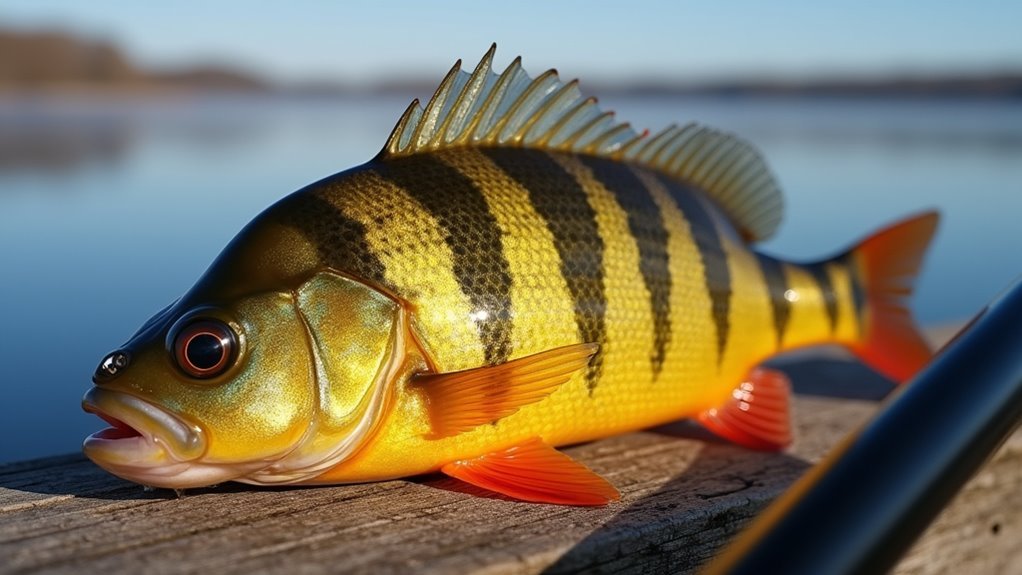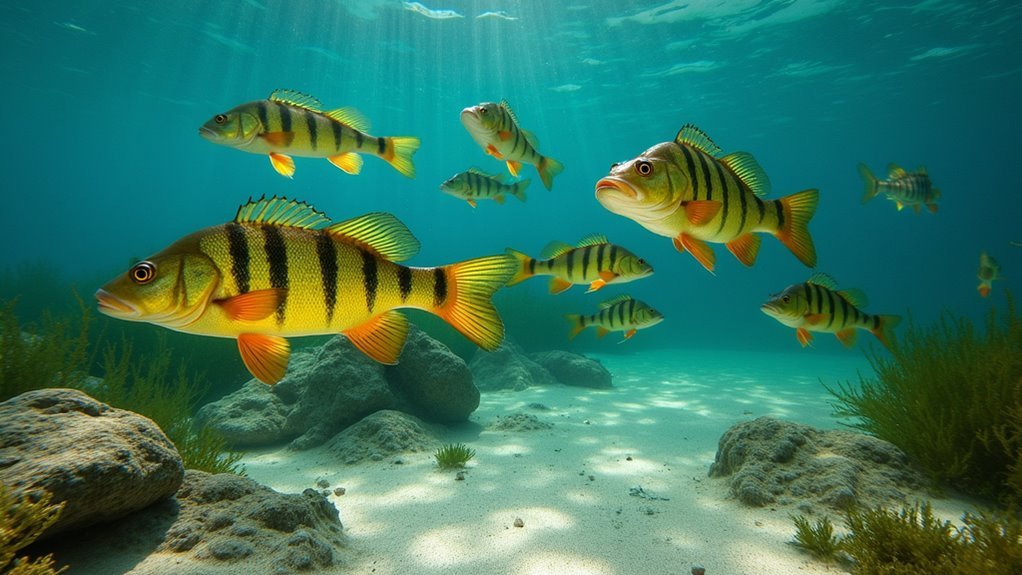Mastering yellow perch fishing requires understanding their seasonal patterns and habitat preferences. These golden-barred fish typically school in similarly-sized groups, making for productive catches once located. Light tackle works best—a 6-foot graphite rod paired with 6-pound line and size 4-8 hooks. Bait choices should vary with seasons: small worm segments work year-round, while minnows attract trophy specimens. Perhaps most importantly, follow their migration from shallow spring spawning areas to deeper summer haunts. Further techniques await those ready to elevate their perch game.
Yellow Perch: Know Your Target

Identification marks the first crucial step in any successful fishing endeavor.
Yellow perch display distinctive characteristics that make them relatively easy to spot among other freshwater species. Their elongated bodies mirror miniature walleyes, while their coloration—ranging from pale yellow to rich gold with seven dark vertical bars—serves as nature’s unmistakable signature.
The distinctive golden hue and seven vertical bars make yellow perch nature’s own signature among freshwater fish.
Most adult perch measure between 6 to 10 inches, though some impressive specimens exceed 12 inches and weigh over a pound.
Perhaps their most social trait is their tendency to congregate in schools of similarly-sized individuals. This behavior, I think, explains why anglers often catch multiple perch of uniform size in quick succession.
Essential Tackle and Equipment Setup
Success in perch fishing often hinges on using the right equipment for the job. A light graphite rod over 6 feet paired with an open-faced spinning reel creates the ideal setup for handling these feisty fish.
Most anglers find that 6-pound monofilament line offers the perfect balance of strength and sensitivity.
Hook selection matters too – sizes 4 to 8 work best, with larger hooks actually being easier to remove.
I think having an assortment of light sinkers is essential for keeping your bait where perch are feeding, typically near the bottom.
Perhaps the simplicity of this setup is what makes perch fishing so accessible to beginners.
Bait Selection Strategies for Every Season
Versatility in bait selection often makes the difference between a memorable day on the water and going home empty-handed when targeting yellow perch.
These opportunistic feeders shift their preferences as water temperatures and available food sources change throughout the year.
In spring, when perch move to shallow spawning grounds, smaller offerings typically outperform larger baits.
I think summer calls for a more diverse approach, as perch scatter across different depths.
- Live earthworms cut into smaller sections – a year-round classic
- Small minnows (1-3 inches) – particularly effective for trophy perch
- Larvae (wax worms, maggots) – perhaps the top choice for ice fishing
- Crayfish – excellent for targeting larger perch in deeper water
- Bright artificial lures – white and chartreuse work well in murky conditions
Locating Prime Yellow Perch Habitat

Finding yellow perch means understanding where they prefer to live throughout the changing seasons. These fish are quite predictable in their movements if you know what to look for.
During spring spawning, target shallow waters (when temperatures hit 45-52°F).
By summer, the larger adults migrate to deeper rocky areas—first to 8-12 feet by June, then 25-35 feet by August. The smaller ones might hang around in the shallows year-round, I think.
In rivers, which aren’t their preferred habitat, focus on deep pools near rocky cover.
Winter requires patience—search mid-depth basins where perch often suspend off the bottom.
Seasonal Fishing Techniques That Produce Results
Every successful angler knows that adapting techniques to match seasonal patterns drastically improves yellow perch catches throughout the year.
As water temperatures shift through the seasons, perch behavior changes predictably, requiring different approaches to consistently find success.
- Spring – Target shallow spawning areas (45-52°F) with small minnows or worm segments
- Summer – Follow larger perch to deeper rocky areas (25-35 feet by August)
- Fall – Focus on deep, rocky habitats where they feed heavily before winter
- Winter – Search mid-depth basins; perch often suspend off bottom
- Shifting periods – Use active jigging techniques when perch are on the move
I think the most overlooked factor is perhaps how drastically depth preferences change season to season.
Advanced Tips for Landing Trophy-Sized Perch
While most anglers are satisfied catching average-sized yellow perch, dedicated fishermen know that targeting trophy specimens requires specialized techniques and considerable patience.
Focusing on deeper waters where larger perch tend to congregate is perhaps the most critical strategy, especially during summer months when they migrate to depths of 25-35 feet.
Using larger baits like small minnows or crayfish tends to attract bigger perch, as they’re more attracted to substantial meals. I think switching to slightly heavier tackle—maybe 8-pound test—gives you better control when fighting these larger fish.
Morning and evening hours typically yield better results for trophy perch, particularly when fishing near rocky structures and drop-offs.
Frequently Asked Questions
Can You Safely Eat Yellow Perch From Polluted Waters?
Consumption of yellow perch from polluted waters is not recommended as they can accumulate contaminants. Local fish consumption advisories should be consulted before eating any fish from questionable sources.
How Do Moon Phases Affect Yellow Perch Feeding Patterns?
While research hasn’t definitively linked moon phases to perch feeding, many anglers report increased activity during full and new moons when light levels and tidal movements potentially stimulate more aggressive feeding behavior.
Do Yellow Perch Taste Different Based on Water Temperature?
Water temperature affects yellow perch taste. Fish from colder waters typically have firmer, sweeter flesh, while those from warmer waters may develop a slightly muddier flavor profile.
What’s the Lifespan of an Average Yellow Perch?
These golden swimmers typically grace our waters for 9-10 years, though some fortunate individuals may continue their aquatic journey for up to 11 years under ideal environmental conditions.
How Do Perch Populations Recover After Overfishing?
Perch populations recover through natural reproduction when fishing pressure decreases. Management strategies like catch limits, habitat protection, and sometimes stocking programs help restore sustainable numbers after overfishing impacts.